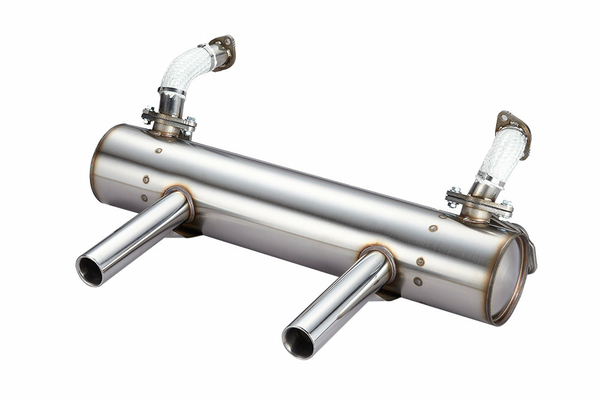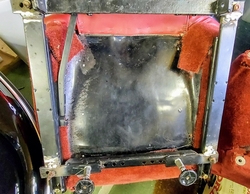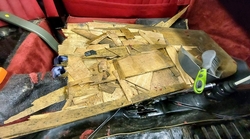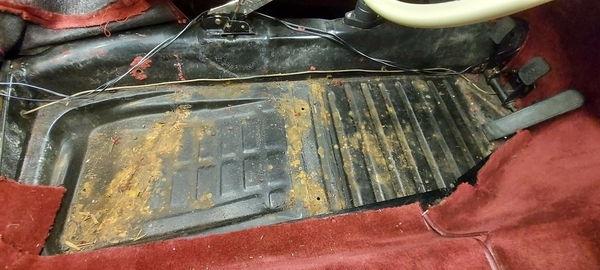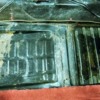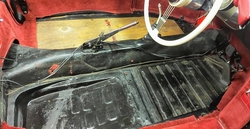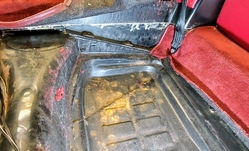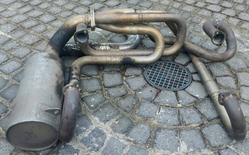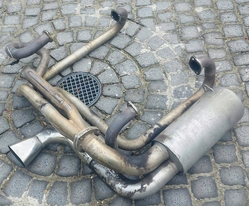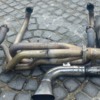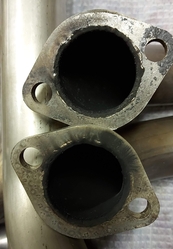The engine has got Dellorto DRLA 40s on it, but I haven’t removed them yet to see the inlet manifold size. I’m not looking for extra power, just reasonable fun up to 70-odd mph and less anti-social noise from the exhaust. The exhaust is a bit of a free flow monster - when I take it off to give it a clean (and to see if I can get a quieter muffler), I’ll take some more pics. But as you can see here, the final output exhaust from the muffler is 63mm/2.5”.
OK, that's the carbs. Displacement, heads, and cam?
@ALB posted:Regarding your steering box (and the adjustment of)- please note that these things don't use "grease", as grease will not flow back into the areas between the gears when it's been "squished out. They use an extremely thick oil which continually flows back into place, which I believe you can make by a bit of grease and oil together. Ages ago I posted a link to a thread on another site which detailed taking one apart and setting it up properly (and what to use as lubricant)- I'll see if I can find it. Al
PS- And to add just 1 more voice- there really is no need to run oil lines all the way to the front of the car (and back). A cooler with temp controlled fan and full flow filter assembly (which, if you pick the right 1 will have a thermostat built in so oil isn't sent to the cooler until the oil need the extra cooling capacity) mounted in the left rear wheel well has already been proven to work and there's not the wasted power of the larger pump pushing oil along 20 extra feet of line.
Even rubber lined stainless steel hose has pumping loss- the best choice is to use teflon lined hose.
Another PS- (the important 1)- I found it- check out Hotrodsurplus's post about half way down the page- rebuilding steering boxes
Stp oil treatment wow that is a blast from the past to use in a steering box 500-600 Weight
here is the text in case the link dies
 | « Reply #18 on: November 08, 2012, 02:35:27 am » |
There is no 'kit' for a steering box. Period. End of story. The only commonly replaceable parts are two seals: one for the input shaft and the other for the sector. They are both available at bearing-supply houses. We bought them in bulk but you can buy them individually for a little more money.
Most--I would say more than 99 percent--of all Type I and III steering boxes are perfectly good inside and worthy of rebuilding. This of course was almost 20 years ago but even the worst looking boxes then were usually good inside.
There are five wear points: 1: from the sector shaft to the housing, 2: from the top of the sector shaft to the steering-box top, 3: between the roller and the sector shaft itself, 4: between the roller and the worm gear, and 5: in the input-shaft bearings.
It was exceedingly rare to find a box that had perceptible wear between the sector shaft and the housing or the sector shaft and the box top. The surface area is so great and the cars are so light that there's almost no real load there. If you want to then you can drop the sector shaft in the housing and check the lateral movement with a dial indicator but I could count the number of boxes that were worn in that way on a wood-shop teacher's hand. And those boxes usually had other problems that prevented their rebuilds.
It would take a really loose fit between the sector shaft and steering box to induce enough movement to wear the box top. That's a really rare case.
You can bore and sleeve worn steering boxes to tighten the fit between the shaft and box but you're just better off starting with another box. That type of wear is so rare that you're not likely to find another one worn that way.
Every once in a while we would come across a sector shaft with a loose roller. The rollers slop sideways when the sector is bad and you just throw those away. Still, that's really uncommon. Those usually came out of Baja bugs and buggies. We got them as loose cores but you could tell the ones that were in off-road cars because they were usually painted funny colors.
The wear between the roller and worm gear isn't exactly common but it's easy to wipe out the fit if you don't know what you're doing. The LAST thing you want to do is touch the screw and jam nut on the steering-box top when the box gets sloppy. That's a sure-fire way to wipe out a worm gear. Trust me on that one.
The fifth type of wear is what makes the boxes sloppy over time. Wear there alters the preload on the bearings on the worm gear (input shaft). Those bearings do wear but they almost never wear out (if water gets into the box it will rust them which destroys the box anyway). That great-big (I think 30mm broach) socket-head fastener is what preloads those bearings. You can't effectively set preload there with the box top and sector shaft in place so you have to remove those parts. You might as well just tear down the entire box while you're at it and replace the seals. Here's how to do it.
Remove the box from the car and clamp it in a vise. Remove the pitman arm and all the grime from the end of the sector shaft. Loosen the jam nut on the box top but don't try to turn the preload screw yet. Remove the four 8mm bolts that hold the box top on to the steering-box housing. Put a drip pan under the steering box and lift the entire top/sector shaft assembly as one unit. Snot will ooze from it if there's any left.
Before you remove the set nut from the preload screw on the box top make sure the threads are good. Otherwise they'll booger up the threads in the box top. Remove the sector shaft from the box top by first removing the set nut and then screwing the set screw down and out of the hole. You'll likely have to grind a screwdriver to get it to go down into the 8mm hole all the way.
Before you go further feel how the input shaft feels in the steering box. It will likely feel loose and spin freely. It doesn't seem like much but even if it just spins freely chances are that's what's causing the box to feel sloppy. It's not uncommon for that shaft to actually feel a little bit sloppy. Those steering boxes feel spooky--you have to turn half a rotation to make the car steer. Usually they're just fine.
Here's how people who don't know what they're doing destroy boxes. They crank down on that jam nut on the top which tightens the fit between the roller and worm gear but it does not do anything about the slop in the input shaft. So they crank down even harder. That makes the steering box feel 'notchy'. After a while the excessive load just wipes out the parts. It doesn't help matters that the steering box is way down on oil at that point. All the while the input shaft moves back and forth making it feel as if the fit between the worm/roller is bad.
Use a big pair of channel-type (Channel Lock) pliers to remove the locking collar from that big ol' set nut. I did that for years and it works fine if you're careful. Then use your new 'tool' to remove that giant preloading fastener. The input shaft drops out through that hole.
You'll have to make your own tool to remove that gigantic set nut that preloads the input. We went down to the local industrial hardware shop (McFadden-Dale's for you California and Las Vegas people) and ordered the right size nut. I just welded a 19mm or so nut to the nut face. The larger nut fits into the fastener and the 19mm or so nut welded to it makes it easy to use a common wrench on the tool.
Before you remove the input shaft, stop and remove the collar that's supposed to be on it. It's not always there but if it is it will tear up the input seal if you try to remove the shaft with the collar in place. There are cases when you can reuse the input seal. They're not always bad.
At this point you can remove the seals and take the parts to your local bearing shop and order new ones.
Clean all of the parts. We ran everything through the washer. We ran everything through the glass-bead cabinet but i have a few tips. First, tape off the part of the sector shaft that fits into the steering box and blast ONLY the area outside the steering box (on the outside of the seal where the pitman arm fits). Sometimes the seal deposits itself on the shaft. In that case POLISH that area to remove the residue. Also blast ONLY the area of the input shaft that's outside the input seal. Again, polish the seal area if it's not squeaky clean. There's no need to blast the bearing races and/or worm gear or roller. That does more harm than good.
You'll likely want to blast the area where the seals were. That's fine but try not to blast the part of the box where the sector shaft fits. It's inevitable that you'll hit that part but just don't sit there blasting. And blast only the topside of the cover. The bottom side of the cover has the precision-machined bore and blasting that area can wear it prematurely. Carefully knock out the filler seal in the box top. Don't try to pry it out because it will likely fall apart. Just punch it out from the bottom.
A circlip holds the set screw in the top of the sector shaft. You don't need to remove it and i don't advise it unless grit has gotten in there. Kymla made me do that and cut out shim stock to go between the set screw and sector to take up the slop but that's wholly unnecessary. Just don't go there if you don't have to.
Reassemble the worm gear with the bearings and the preload fastener. I did the following without the input-shaft seal in place so i could better feel the preload. You can slip the seal over the shaft at a later point but you'll need a thick-walled tube to do seat the seal. Otherwise install the seal with a larger drift and then assemble the input shaft. Squirt some engine oil on the bearings for the time being.
Hokay, the VW manual called out a very specific preload on the input-shaft bearings. It called for a scale in pounds-inches and an arm bolted to a rag-joint coupler. We found that largely unnecessary and i can't remember the specs anyway. Instead, bolt a rag-joint coupler to the input and tighten that preload nut until the slop goes away. Then tighten it more until you can feel the resistance in the input shaft. Then tighten it some more until it gets unnaturally tight and notchy. Now loosen that preload until it takes a bit of wrist effort to rotate the shaft by turning the joint coupler. It shouldn't feel notchy but it shouldn't spin freely either. You should feel a bit of resistance in the bearings. Install the locking collar nut on that giant fastener, hold the fastener in place with your special tool, and check the preload again. You might have to do this a few times if you're working alone.
Now thread the sector-shaft set screw ALL THE WAY UP into the steering-box top. Don't just stop at one point because you can damage things if you try to bolt it all together. Pour some engine oil on the roller and the worm gear.
You don't need the paper gasket to seal the lid to the housing; just use some plain ol' RTV (I use T0y0ta FIP Form in Place and it works awesome). Verify that nothing binds as you tighten the lid. If it binds, take it apart and check for interference. Use the engine specs for the torque on those fasteners.
Now slowly turn the preload screw clockwise as you turn the input shaft back and forth through the whole range. At one point it will get tight enough to feel very slightly notchy at center. You want to go just a little bit beyond that point. It should get almost tight at that point but you shouldn't feel any more than the slightest notchiness in a stock-sized steering wheel. That's absolute center and you want to make a note of that orientation with a mark on the shaft and housing. Now install/tighten the set nut on the preload shaft.
You should now have a properly set steering box. If you haven't installed the seals then do so at this point.
Now you have to fill the box with OIL. NOT GREASE--OIL! And don't try regular gear oil. Those old gearboxes used really thick oil--like 600 weight in early Fords. You can get similar weight oil at industrial shops but there's an easier way. The oil additive STP is super thick--about 500 or 600 weight (at least it used to be). Fill the box through the hole in the top. Fill it all the way and punch the plug back in.
You have a rebuilt box but you're not done yet. The following step is critical and always overlooked.
Remember the 'notchy' part when the steering box is at center? Install the steering box in the car and align it so it's dead-nuts center. Now install the steering shaft and wheel so the steering wheel is perfectly straight and not off to one side or the other when the steering box is centered. Now have the car aligned so the wheels point straight when the steering wheel is pointed straight.
The alignment goes to hell when people lower their cars and align them themselves. They often get the toe in set right but they don't always get the steering wheel centered when the wheels are toed properly. When confronted with that scenario people usually just remove/reinstall the wheel to straighten it out. Well the crooked steering wheel was saying that the steering box wasn't set straight and re-positioning the wheel only covered up the problem instead of correcting it.
That tightness when the box is straight preloads the steering ever so slightly when the wheels are straight. I can guarantee that a good number of you have your steering boxes installed ever so slightly off center--that's really common on lowered or raised cars. An off-center box will feel like junk even if it's perfect. This is experience talking here. I can almost guarantee that those 'junk' TRW boxes were installed that way. At least when I was doing boxes those TRW pieces were top-shelf parts. Preparation and installation are key to a good steering setup.
This may or may not work for you but it worked for me hundreds of times. The steering box in my Thing is one of my rebuilds and 15 years later it's as tight as the day it was made.
@Martin's Eleven (UK) posted:...One question I forgot to ask from a long time ago regarding the sebring style exhaust - why would the PO or original engine builder fit a 40mm ID exhaust when the exhaust manifold is only 34mm ID? I'll dismantle soon and take some pics to see if there is a rational explanation, or if that is 'just the way it is'.
Gordon- you're on the right track. One way of increasing bottom end/lower midrange torque in a higher rpm engine is to downsize the first foot of exhaust tubing off the heads 1 step and then step up the rest of the primary tubes. The engine then has better power down low but can make power and rev to the peak rpm it was designed to.
As for the carburetor/venturi to exhaust size relationship, 40 mm Webers with 34mm vents are capable of over 150 hp on an aircooled opposed engine. Your exhaust inner diameters translate to 1 1/2 and 1 5/8" tubing and on a 1905 (74x90.5) the larger size will let the engine breathe to over well 7,000 rpm. Whether the engine has the valve sizes/porting work and the camshaft specs is another story. 
Turbo Thomas is somewhat local to you (sorry, where he resides in jolly old England I know not- all I know is English he be) and iIrc he makes Sebring exhausts for VW engines- it could be one of his?
I read the thread from the beginning before starting this to familiarize myself with what you had; I guess I never read the whole thing, so- yes, those are drop spindles (they do add 1/2 or 5/8" width to each side), but even with 5½ or 6" Fuchs and wider tires (a friend runs 205's with 7" Fuchs on the front of his Beetle) it doesn't affect steering geometry, handling or effort that much. What did you finally end up with for tires? And love the new stance- the car looks great black with the alloys. Are they chromed or polished? Btw- to be really badass it could be a wee bit lower... ![]()
And while there's nothing wrong with the alloy cast copies and when paint detailed properly it's hard to tell them from the real thing, I took the trouble to find genuine Fuchs. I did at first own fakes for my Speedster, but when the opportunity to buy some originals at a very good price came up (I traded some stuff for them and the guy really wanted what I had), since the Fuchs are 3½ or 4 pounds lighter per wheel it was a no brainer. I've since widened 1 pair an extra inch to the inside (they're now the same dimensions as the ultra rare 1967 911R rear 7" wheel) and boy, I love the look with 195's on the back! (yeah, I know, I have to finish the thing and get it out of the garage!)
Attachments
To quote @edsnova from my initial post with photo of the engine work invoice: “74mm crank, 90.5 bore. You have a 1904cc engine. HD valve springs and dual 40s suggest some cammage was employed; interesting that the cam and head/valve specs are omitted.”
I’ve still to hear back from the engine builder on what cam was fitted. Given the build was in 1997, they probably won’t have records from that time. To be honest, until I get some more measurements & photos of inlet and exhaust manifold, the original question was more theoretical than actual.
@Martin's Eleven (UK) posted:To quote @edsnova from my initial post with photo of the engine work invoice: “74mm crank, 90.5 bore. You have a 1904cc engine. HD valve springs and dual 40s suggest some cammage was employed; interesting that the cam and head/valve specs are omitted.”
I’ve still to hear back from the engine builder on what cam was fitted. Given the build was in 1997, they probably won’t have records from that time. To be honest, until I get some more measurements & photos of inlet and exhaust manifold, the original question was more theoretical than actual.
Even if he keeps records, don't expect him to have anything from that far back. Unless that engines sticks out for some particular reason he won't remember anything about it. I'm a house painter and whenever a client asks (sometimes years later) what color/material was used somewhere the answer is always the same- I told you to write all this down when the work was done as I don't keep any of this.
If you want to know what cam is in it- pull the oil pump (after loosening the case bolts around it). Most aftermarket cams are marked on the gear end as to what they are. If it isn't (or what's there doesn't correlate with anything from any of the established VW cam manufacturers) it could be a regrind or from someone who doesn't regularly grind VW cams. You can pull a carb and intake manifold to get a look at the intake porting but you'll have to pull a head to measure valve sizes and see what combustion chamber work was done.
Take it out and in 3rd gear run it full throttle up to where power starts to drop off, noting where the power really started to 'come on' as well. It will probably rev anywhere from 4 or 500 to close to 1,000 rpm more but you want to feel where the engine actually peaks and stops making additional power. That's your absolute redline, as revving it any higher won't make the car any faster and will just hasten wearing out or outright breaking valve train parts. If you can give me approx where power starts and stops I can give you an idea of what type of cam may be in it.
Hope this helps. Al
@ALB thanks for the info and kind words on the car. For now she’s still on 195/55x15s, and the alloys are chromed, not polished. Just by adjusting the steering box and cleaning, greasing and double checking everything the ease of steering has improved.
I was waiting to get all that done before taking it to get a proper alignment which I think will help improve steering greatly. It felt out of kilter when I initially drove it - like the tracking was way off. I may still go for narrower tyres but given this car was so badly set up by the PO I’m planning on doing an ‘Alt Ctrl Del’ to reset the car before taking more drastic/ expensive action.
And as for ‘badass’, the poor state of English roads means I can’t go too low. Speed bumps, of which there are many on urban roads and car parks, mean that too low = beaching or severe engine damage.
A previous car of mine (Nissan Cube below) was so low it actually got beached on a country road where the camber was so extreme, and it always graunched its way over some fairly tall speed bumps ( also known as ‘sleeping policemen' in UK) - in the end that was the main reason for selling.. But that car’s lowest point was the body and exhaust, not engine sump - hence my desire to balance badass with safety.
I’ve just googled Turbo Thomas and he’s around 110 miles from me, so I’ll see if I can find someone closer (I know, those distances are nothing to those of you on the American continent).
Attachments
"I'm a house painter and whenever a client asks (sometimes years later) what color/material was used somewhere the answer is always the same- I told you to write all this down when the work was done as I don't keep any of this."
Attachments
Hi Al, thanks again for further diagnostic info. For now the car is on axle stands and won’t be going anywhere soon as I work my way from front to back. But your ‘3rd gear’ advice is a practical way to find powerband. I’ve not got the space in my garage to drop the engine to do further diagnostic work so I’ll leave that to the local air cooled specialist when he relocates my oil cooler. I’m not in a rush to find cam profiles etc but it would be useful to see the engine big picture.
Or, you could take the “laid back surfer” @MusbJim approach:
Just drive it.
While you’re messing around the front end, don’t forget to pump a bunch of grease into the nipples top and bottom, at the left and right sides of the front beam. The bushings/bearings get dry over time and need rejuvenation every few years.
Hey @Bob: IM S6 
Good thing you're more than 2 meters away...![]()
Attachments
I like the idea of simply greasing my nipples and driving into the sunset..
HEY! Let's keep it clean ![]()
Thanks, @Martin's Eleven (UK). Given what you've said, I'd agree-- the exhaust seems a bit big for the engine.
@Martin's Eleven (UK) posted:The engine has got Dellorto DRLA 40s on it, but I haven’t removed them yet to see the inlet manifold size. I’m not looking for extra power, just reasonable fun up to 70-odd mph and less anti-social noise from the exhaust. The exhaust is a bit of a free flow monster - when I take it off to give it a clean (and to see if I can get a quieter muffler), I’ll take some more pics. But as you can see here, the final output exhaust from the muffler is 63mm/2.5”.
You seem like you might be a perfect candidate for a Vintage Speed canister exhaust system.
I (personally) like what you've got better, but given what you know about your engine and what you've conveyed in the highlighted portion-- something like this might be what you are looking for. New to the Vintage Speed site is a chart for their exhausts. I think ALB's chart is better for those of us interested in power above all else, but Vintage Speed seems to understand that sound and packaging is more important to a lot of people than getting everything possible from their engines.
Given this chart, I think I'd go with a 143mm in a 38 mm primary (1-1/2").
As an aside, a guy can get really, really deep into exhaust theory. An excellent resource is A.G. Bell's book, 4-Stroke Performance Tuning, particularly the chapter on exhaust design.
... but at the end of the day, the exhaust needs to meet 3 different criteria:
- It needs to physically fit. This is a lot harder with a rear-mounted engine horizontally opposed cylinders than it would be in an inline 4 or V8 mounted conventionally in the front.
- It needs to perform well. Packaging limits what is possible here.
- It needs to sound good. Short tail-pipes on 4/1"extractor" type headers are loud. Packaging longer tail-pipes is tough.
The Vintage Speed canister fits points 1 and 3 perfectly, and are probably completely adequate for a sub 2L engine as it pertains to point number 2.
Everybody has to live with an exhaust that does no more than 2 things really, really well. If it does 2 things well and the other adequately, that's as good as it's likely to get.
Good luck.
Attachments
Your not kidding Bob, great information Stan.
I do think if an you really want the most ultra quiet design you would have to have it custom made like the ones IM make with two mufflers, at least that is the info that IM shared with me of their trial and errors with mufflers with heat exchangers.
.
@Martin's Eleven (UK) , here's what a Vintage Speed exhaust sounds like on my car - a mild, 2-liter. I wasn't looking for Gonzo power in this build - just decent low-end torque and reliability in California's hot central valley.
I also wanted to avoid ground clearance issues, as our driveway has a difficult entrance. As the video clip shows, this system is quiet to the point of being boring - just like me.
.
Quick question for guys without heat.
Which J pipes are used with the Vintage Speed Exhaust ?
@thedak I've no idea what J pipes you'd need but probably you'll be better off posting a separate question in the General Technical section - you're more likely to get some answers there. Good luck!
Anlther update as I move from front to back of the car. This time its the middle interior section. I needed to get the seats moving smoothly because the runners kept jamming. I soon found out why - all four parts of the square frame that is bolted to the floor at the front were simply bolted together, not welded, so moved out of square every time pressure was applied fore or aft. I managed to get my brother to weld them up before the whole country went back into lockdown at the beginning of this week.
Before I bolted the seat back in place I checked under the carpet and found a delaminating plywood floor board, so that had to come up too, because if there'd been enough water to delaminate the board, there's sure to be rust underneath. Sure enough..
So a wirebrush and some Jenolite has sorted that - luckily it's only superficial.
Once dry I'll paint it over and possibly add some sound deadening. In the meantime it's off to the DIY store for some new plywood (12mm). Since I've got to varnish a reconditioned birdbox for the garden I'll probably use the Marine Varnish to protect the plywood here after cutting it to shape.
It's a tricky shape to get in because the outer edge fits in the channel made by the Chesil body and the VW floor and everything is bolted together. The build instructions actually state: "before fitting the bodyshell, fit the floorboards now. They are not removable once the body is in place." Damn right they aren't - I had to cut them out with a disc cutter. So I'll have to find a way of getting the floorboard back in without lifting the bodyshell - probably making it in sections. I'll post here how I manage it. If anyone has any suggestions, please chip in!
Attachments
Not to sound like a dummy, Martin, but what is the purpose of the piece of plywood? Even though our metal floor looks just like yours (rust and all), none of the cars on this side of the pond use any plywood. Our seat glides are just mounted right onto the metal floor. Once they're in there I've never noticed the floor flexing at all.
Just curious. Chesil certainly must have gone that route for a reason.
X2 on what Gordon is saying-- I'd not put it back in at all.
Without it you'll sit lower in the car, which is a good thing, unless you're 4 foot tall.
.
Remember, guys, the Chesil is an English car.
It was born on the Dorset coast.
I think the wood is there to absorb moisture from the air and to encourage mold, which, in time, imparts that unmistakable British character to a car. You just can't do that with fiberglass.
.
Not that we haven’t tried to get moldy fiberglass at a number of Carlisle gatherings... ![]()
Had old '59 MGA - plywood floors too.
@Gordon Nichols and @Stan Galat - I think it was originally done to provide a flat foor for carpeting and a clean base for seats - I'm guessing there might be discrepancies in floor height if people shortened the chassis in differing ways. This way, the floor would be a consistent height for the seat rails. Perhaps it's a legacy from Buggy builds of the 70s? Or it could be, as Mitch says, simply a way if incorporating wood somewhere so that something can rot instead of rust!
However, I've sized up the seats without the wood floor and it's a no for a couple of reasons.
- Without the wooden floor, the seat is TOO low. I can barely see over the bonnet. This is because the seat runners are set low on the seat, so there's only about 1.5" between the floor and the seat base. I would need to fabricate taller seat mounts to balance things out.
- The way the Chesil is designed, there's around a 2" ridge parallel to the floor that sits tightly over the plywood. If I remove the wood, I'd have to shave this metal part of the subframe down to not interfere with the seats and carpeting.
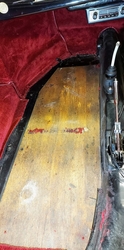
It's obviously a design feature that simply has to be accepted. So I'll be buying some fresh plywood tomorrow and crack on with cutting out some new boards - I'll split them in two (front/back) just forward of the seat mounting holes, so I can fit them without removing the body. This will still work in terms of keeping the seat mounting safe.
However, as usual, I'm finding more issues that are more problematic and/or dangerous with a second-hand replica than a production saloon. It just goes to show (as all of you know) that some people who are not mechanically minded and are buying these on BAT because they're trendy and pretty are potentially buying deathtraps. More so in the UK because any car built before 1973 doesn't need an MOT (yearly test of roadworthiness). Even an MOT doesn't necessarily pick up problems either, so the tyres rubbing against brake hoses, chafed oil cooler hose, loose body mountings, dodgy steering crush cage, all the oil over the gearbox and the leaking CV joint throwing grease everywhere - none of these were picked up in the MOT the PO got before selling the car.
If you read a previous post of mine berating the state of the UK kit car market back in the 90s, you'll see why I have this opinion - some of the welds on this car are pitiful. Huge blobs, some unwelded gaps, none of the lumpiness ground down to be smooth, no primer or any kind of rust proofing paint before a quick squirt of sealant is smoothed over to cover up any ugliness.. Hence the rust you see here - perhaps the wood is in place merely to hide the rust?? ;-) Thank goodness quality control has got better in recent years.
So, I found a significant number of bolts between chassis and subframe are loose - no wonder the car shuddered and clonked over bumps. All duly tightened - I'm so looking forward to seeing how this car drives once finished!
The new CV joints and driveshafts arrived in the post today - it was almost as cheap and far easier to buy an entire driveshaft with both CV joints for £91 (about $121) rather than buying two CV joint kits and doing all the disassembling/reassembling. And of course it made sense to buy both rather than just the one that had thrown grease. So I'll fit them at some point in the next week.
One bit of great news is the Dellorto Super Performance manual finally arrived - I'd been hunting for three months in the UK before one finally turned up on Ebay. So I'll be using this when I get to grips with the DRLAs. :-)
Attachments
Martin wrote: “it was almost as cheap and far easier to buy an entire driveshaft with both CV joints for £91 (about $121) rather than buying two CV joint kits and doing all the disassembling/reassembling.”
I’ve been saying that for a while, but then I’m inherently lazy and don’t like axle boot replacement. ![]()
There has been our share of home built cars over here, too, often done as a family effort without the benefit of good mechanic experience. @Alan Merklin has seen his share of those, others, too. And then there are those others built at home that are superbly done. Kind of a toss-up.
Look on the bright side, though, Martin.... Once you finish, it will be done RIGHT! (And then you can be like some of us, coaching others through their build!)
At least by the time I’ve finished this one I’ll know pretty much everything I’ll need to know about Chesil Speedsters for when I buy my next one..
@Gordon Nichols I’m with you - axle boots are messy at the best of times, so for a little more money the reduced hassle and peace of mind is worth it.
Oh, and @Gordon Nichols don’t forget this was a factory build. Most home builds I’ve seen are far better quality - they take the time to get it right and don’t do shortcuts. At least in England. I can’t comment on US factory builds..
@Martin's Eleven (UK) posted:Oh, and @Gordon Nichols don’t forget this was a factory build. Most home builds I’ve seen are far better quality - they take the time to get it right and don’t do shortcuts. At least in England. I can’t comment on US factory builds..
Let's hope Westfield Sportscars Ltd is doing a better job building them now that they purchased Chesil.
@Martin's Eleven (UK) posted:@Gordon Nichols I’m with you - axle boots are messy at the best of times, so for a little more money the reduced hassle and peace of mind is worth it.
Good thing it's a VW. The Cayman axles are upwards of $800-900. But the boots are $8 each. I guess I'll be swapping my just-starting-to-crack boots. All four will be replaced in the spring.
Martin, your car is going to be fine, your work ethic will get you through. You're doing great.
I could be wrong, @Robert M , but I think one of the reasons of the purchase by Westfield would have been to increase professionalism and quality of the commercial offering. As they’ve shown with their Westfield 7s, there’s a ready market for quality, ready-built versions of what originally was a kit offering only. I’m sure that’s the way the market is heading. But that will have knock-on benefits for us tinkerers too - better spare parts supply, better engineering design etc.
Thanks for your kind words @DannyP (and the rest of you guys!) - helps keep me going when I’m lying on the floor in 3C/37F garage temp skinning my knuckles! A UK garage built in approx 1970 (the house was built 1928) is not known for being draught-proof or easy to heat.
I built my current garage (my second in five houses) back in 2006-ish. Nice smooth concrete floor, no drafts, insulated but no heat (yet). Unfortunately, the insulation moderates the temp inside where it's often colder in than out. Right now, at 11am in New England, it's the same temp inside as your place (3C/37F) - Must be why they call this "New" England, right?
Just got my car up on jack stands a couple of days ago as I'm doing some mods to the gas heater control circuitry. The heater's in the nose of the car so half the time I get to sit on a roll-around shop stool and the other half I'm lying under the dash. ![]() That whole under-dash thing gets old quickly when you're my age.
That whole under-dash thing gets old quickly when you're my age.
So what do you do when you're not spanning on the car, and did Portsmouth get hit by Storm Filomenia as Spain did?
Gordon, humidity is a pain in a garage and it adds to the coldness IMO.
I have an insulated garage and I have been heating it for the last 2-3 years with an overheat heater on 220v . It is doing the job but I often think of running pex in or on the floor and a water heater to heat the 24x24 garage.
Covidly speaking we redid our master washroom and added pex and water heating under the tiles, the floor is really nice and warm and dampness is non existent.
I got fed up working under the car with so much stuff in the way so took the exhaust off this afternoon. It takes up so much space it’ll make getting to other parts, such as driveshafts and valve clearances so much easier, as well as giving me a chance to check the exhaust over and clean it up - as you can see it’s covered in burnt oil from the numerous leaks this car has had in the past.
It’s very light weight - the whole system weighs less than my Volvo muffler. Thin wall stainless. I’m intrigued now so will weigh it this week.
Attachments
Sidewinder, basically. That's a good header.
@Gordon Nichols luckily for us we missed the snow. It’s been bitterly cold for a fortnight now which is unusual for us - normally weather changes after a week. It’s a very damp cold though, which always feels so much worse. I was in Calgary once on business (QSound) and it was -35C but weirdly it didn’t feel as cold as UK, but every time I breathed in, the inside of my nose crinkled like the black crackle dash on an MG. The damp is the problem in the garage so I have a dehumidifier but that only really works above 8C.
Outside of spannering, I work in digital health. I’m semi-retired/consulting a few days a week now but worked for the NHS for 10years until last January. I helped create and ran all the interactive health tools on the NHS website, including the BMI Calculator and Heart Age Test (which tells you your heart age compared to your real age). I’ve been in digital since ‘86 when I worked for an Atari ST magazine before joining MicroProse (which had its US HQ in Hunt Valley, MD) during its glory years of the ‘90s to work on the World Circuit Grand Prix sim (amongst others). Happy days!
Cleaning up the exhausts, I spot this:
Cylinders 3 and 1
Cylinders 4 and 2
hmm, I knew the Dellortos were seriously out of whack but I’ll have to keep an eye on this. Obviously I’ve still to check valve clearances and check the Porsche-style fan shroud is working correctly. Is this just fuelling or do I need to look for something else? 4 and 2 look very lean, they’re almost clean inside, whereas 3 and 1 are very sooty.
Attachments
It looks like you said, which is often just a mixture screw adjustment. It also looks like no gaskets were used between the heads and exhaust flanges. I have copper re-usable gaskets, the same ones since 2005. Pretty durable I'd say. I don't know if they're still available.
There were gaskets between headers and exhaust flanges, but they were pretty much disintegrated, hence the leaks. Also the entire exhaust is push fit with no paste to seal gaps, so there are a few small leaks along the way. It seems a good system though as @edsnova mentioned above. I just need to make it a fraction quieter. I'll look into copper gaskets - thanks for the tip @DannyP.
Back in the interior, I've got the plywood on order (since lockdown we can't 'click and collect' large items, so it has to be delivered) to make the floorboards. Once those are in, the interior can be reassembled until such time as I can get it to the trimmers to redo the carpet and torn seats. The red carpet and red seats is overkill IMO (a bit 1970's shagpile boudoir, rather than crisp Germanic four weave primness), and the reds don't quite match, so I'm heading towards a beige/oatmeal carpet and keeping the door trims and seats red. That should lighten up the interior considerably and make it more functional and less lush! (examples are here and here). It should go well with the black body.







